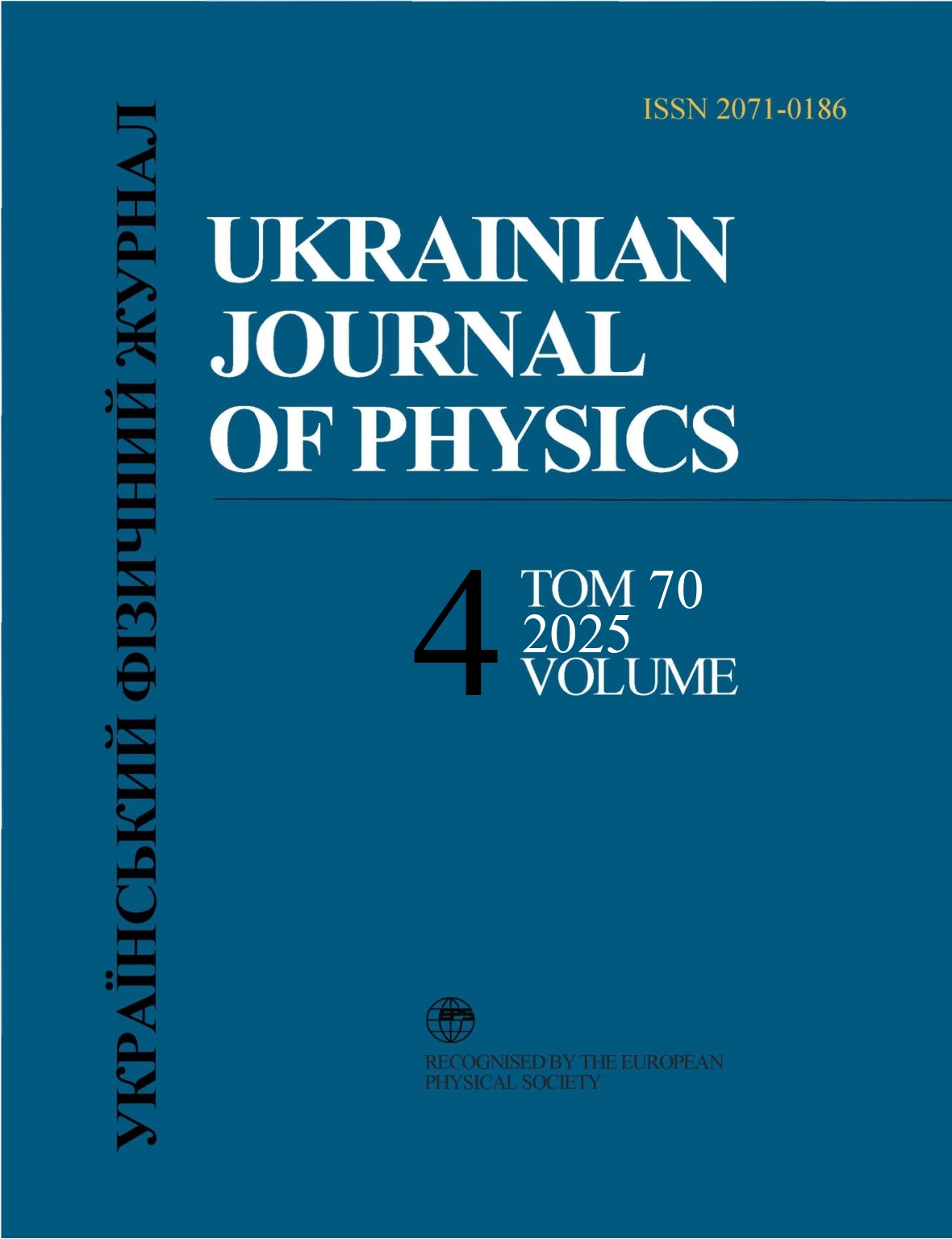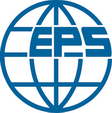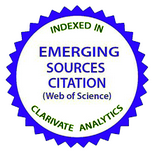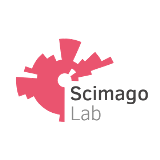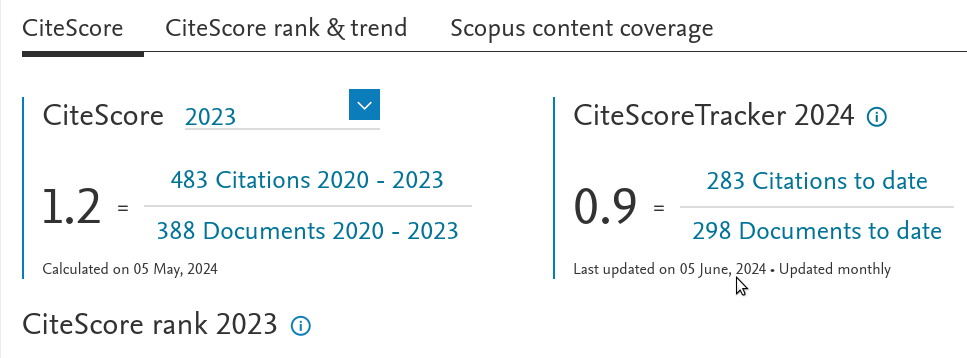Comparison of Optical and Energy Characteristics of Excitons in Aqueous Solutions and Solid Films of Quantum Dots
DOI:
https://doi.org/10.15407/ujpe70.4.251Keywords:
Stokes shift, quantum dot, excitation energy, exciton, ZnSeAbstract
The results of studies of colloidal solutions of ultra-small ZnSe quantum dots (QDs) stabilized by short thioglycerol molecules and their dense films, which constitute the material basis of optoelectronic structures, are reported. A comparison of the results obtained for the solutions and the films makes it possible to better understand the transformation of corresponding optical characteristics during the transition from a system of non-interacting particles in the solution to a system with strong interaction between QDs. Delocalization of excitons and hybridization of their wave functions create a new set of QD energy states in the films, which govern the transport and optical properties of the latter. A substantial red shift between the absorption spectra of the solution and the film has been revealed, the nature of which is determined by strong interaction among the QDs. The researched dynamic characteristics showed that the time of the exciton excitation energy transfer in the films of ZnSe DQs with strong interaction can be subnanosecond (≈610 ps) and dominate over the time of internal exciton relaxation into in-gap, surface, and defect states of charge carriers.
References
1. J. Lihong, S.V. Kershaw, L. Yilin, H. Xiaodan, L. Yingying, A.L. Rogach, G. Mingyuan. Aqueous based semiconductor nanocrystals. Chem. Rev. 116, 10623 (2016).
https://doi.org/10.1021/acs.chemrev.6b00041
2. C.L. Bassani et al. Nanocrystal assemblies: current advances and open problems. ACS Nano 18, 14791 (2024).
https://doi.org/10.1021/acsnano.3c10201
3. N. Hildebrandt et al. Energy transfer with semiconductor quantum dot bioconjugates: a versatile platform for biosensing, energy harvesting, and other developing applications. Chem. Rev. 117, 536 (2017).
https://doi.org/10.1021/acs.chemrev.6b00030
4. D. Perera, R. Lorek et al. Photocatalytic activity of core/shell semiconductor nanocrystals featuring spatial separation of charges. J. Phys. Chem. C 116, 22786 (2012).
https://doi.org/10.1021/jp308921s
5. T. Mirkovic, E.E. Ostroumov, J.M. Anna, R. van Grondelle, G.D. Scholes. Light absorption and energy transfer in the antenna complexes of photosynthetic organisms. Chem. Rev. 117, 249 (2017).
https://doi.org/10.1021/acs.chemrev.6b00002
6. G. Shi et al. The effect of water on colloidal quantum dot solar cells. Nat. Comm. 12, 4381 (2021).
7. L. Yun, K. Donghun, P.M. Owen, D. Zhitomirsky, J.C. Grossman. Origins of the stokes shift in PbS quantum dots: impact of polydispersity, ligands, and defects. ACS Nano 12, 2838 (2018).
https://doi.org/10.1021/acsnano.8b00132
8. Hua Li et al. Elucidating the mechanisms of the large stokes shift in isolated and coupled PbS quantum dots. J. Phys. Chem. C 128, 8732 (2024).
https://doi.org/10.1021/acs.jpcc.4c02008
9. M.V. Bondar, M.S. Brodyn, Y.P. Pyryatynskyi, N.A. Matveevska. Stationary spectroscopy and sub-nanosecond resonant energy transfer of exciton excitation of aqueous solutions and films of ZnSe nanocrystals. Ukr. J. Phys. 67, 544 (2022).
10. O. Voznyy et al. Origins of Stokes shift in PbS nanocrystals. Nano Lett. 17, 7191 (2017).
https://doi.org/10.1021/acs.nanolett.7b01843
11. M. C. Brennan, J.E. Herr, T.S. Nguyen-Beck, J. Zinna, S. Draguta, S. Rouvimov, J. Parkhill, M. Kuno. Origin of the size-dependent Stokes shift in CsPbBr3 perovskite nanocrystals J. Am. Chem. Soc. 139, 12201 (2017).
https://doi.org/10.1021/jacs.7b05683
12. Th.A. Klar, Th. Franzl, A.L. Rogach, J. Feldmann. Superefficient exciton funneling in layer-by-layer semiconductor nanocrystal structures. Adv. Mater. 17, 769 (2005).
https://doi.org/10.1002/adma.200401675
13. N.V. Bondar, M.S. Brodyn, N.A. Matveevskaya, T.G. Beynik. Efficient and sub-nanosecond resonance energy transfer in close-packed films of ZnSe quantum dots by steady-state and time-resolved spectroscopy. Superlatt. Microstruct. 130, 106382 (2020).
https://doi.org/10.1016/j.spmi.2019.106382
14. N.V. Bondar, Yu.P. Pyryatynsky. Arrays of size-dispersed ZnSe quantum dots as artificial antennas: role of quasicoherent regime and in-gap states of excitons for enhanced light harvesting and energy transfer. Curr. Appl. Phys. 48, 114 (2023).
https://doi.org/10.1016/j.cap.2023.01.007
15. J. Giblin, M. Kuno. Nanostructure absorption: a comparative study of nanowire and colloidal quantum dot absorption cross sections. J. Phys. Chem. Lett. 1, 3340 (2010).
https://doi.org/10.1021/jz1013104
16. Qiuyang Li, Kaifeng Wu, Haiming Zhu, Ye Yang, Sheng He, Tianquan Lian. Charge transfer from quantum-confined 0d, 1d, and 2d nanocrystals. Chem. Rev. 124, 5695 (2024).
https://doi.org/10.1021/acs.chemrev.3c00742
17. N.C. Anderson, M.P. Hendricks, J.J. Choi, J.S. Owen. Ligand exchange and the stoichiometry of metal chalcogenide nanocrystals: spectroscopic observation of facile metalcarboxylate displacement and binding. J. Am. Chem. Soc. 135, 18536 (2013).
https://doi.org/10.1021/ja4086758
18. S.F. Wuister, C. de Mello Donega, A. Meijerink. Influence of thiol capping on the exciton luminescence and decay kinetics of CdTe and CdSe quantum dots. J. Phys. Chem. B. 108, 17393 (2004).
https://doi.org/10.1021/jp047078c
19. J. Eilers, J. van Hest, A. Meijerink, C. de Mello Donega. Unravelling the size and temperature dependence of exciton lifetimes in colloidal ZnSe quantum dots. J. Phys. Chem. C. 118, 23313 (2014).
https://doi.org/10.1021/jp5038238
20. D.H. Nguyen, Sung Hun Kim, Joon Sue Lee, Dong Su Lee, Hong Seok Lee. Reaction-dependent optical behavior and theoretical perspectives of colloidal ZnSe quantum Dots. Sci. Rep. 14, 13982 (2024).
https://doi.org/10.1038/s41598-024-64995-5
21. R. Toufanian, Z. Xingjian, J.C. Kays, A.M. Saeboe, A.M. Dennis. Correlating ZnSe quantum dot absorption with particle size and concentration. Chem. Matt. 33, 7527 (2021).
https://doi.org/10.1021/acs.chemmater.1c02501
22. R. Yousefi, H.R. Azimi, M.R. Mahmoudian, W.J. Basirun. The effect of defect emissions on enhancement photocatalytic performance of ZnSe QDs and ZnSe/rGO nanocomposites. Appl. Surf. Sci. 435, 886 (2018).
https://doi.org/10.1016/j.apsusc.2017.11.183
23. Desong Guo et al. Doping of Mn2+ into aqueous ZnSe nanocrystals with pure dopant emission through a lightinduced electrostatic attraction and diffusion method. J. Phys. Chem. C. 125, 989 (2021).
https://doi.org/10.1021/acs.jpcc.0c09023
24. C.S. Ponseca, Jr., P. Chabera, J. Uhlig, P. Persson, V. Sundstr¨om. Ultrafast electron dynamics in solar energy conversion. Chem. Rev. 117, 10940 (2017).
https://doi.org/10.1021/acs.chemrev.6b00807
25. P.C. Sercel, Al.L. Efros, M. Rosen. Intrinsic gap states in semiconductor nanocrystals. Phys. Rev. Lett. 83, 2394 (1999).
https://doi.org/10.1103/PhysRevLett.83.2394
26. Y. Zhang, D. Zherebetskyy, N.D. Bronstein, S. Barja, L. Lichtenstein, A.P. Alivisatos, Lin-Wang Wang, M. Salmeron. Molecular oxygen-induced in-gap states in PbS quantum dots. ACS Nano 9, 10445 (2015).
https://doi.org/10.1021/acsnano.5b04677
27. Zaiping Zeng et al. Size engineering of trap effects in oxidized and hydroxylated ZnSe quantum dots. Nano Lett. 22, 3604 (2022).
https://doi.org/10.1021/acs.nanolett.2c00118
28. Zaiping Zeng et al. Bulk-like ZnSe quantum dots enabling efficient ultranarrow blue light-emitting diodes. Nano Lett. 21, 7252 (2021).
https://doi.org/10.1021/acs.nanolett.1c02284
29. M. Abdellah, K.J. Karki, N. Lenngren et al. Ultra longlived radiative trap states in CdSe quantum dots. J. Phys. Chem. C 118, 21682 (2014).
https://doi.org/10.1021/jp506536h
30. T. Hanrath. Colloidal nanocrystal quantum dot assemblies as artificial solids. J. Vac. Sci. Technol. A 30, 030802 (2013).
https://doi.org/10.1116/1.4705402
31. R.D. Harris, S.B. Homan et al. Electronic processes within quantum dot-molecule complexes. Chem. Rev. 116, 12865 (2016).
https://doi.org/10.1021/acs.chemrev.6b00102
32. W. Jaskolski, G.W. Brayany et al. Artificial molecules. Quant. Chem. 90, 1075 (2002).
https://doi.org/10.1002/qua.10331
33. N. Kholmicheva, P. Moroz, H. Eckard, G. Jensen, M. Zamkov. Energy transfer in quantum dot solids. ACS Energy Lett. 2, 154 (2017).
Downloads
Published
How to Cite
Issue
Section
License
Copyright Agreement
License to Publish the Paper
Kyiv, Ukraine
The corresponding author and the co-authors (hereon referred to as the Author(s)) of the paper being submitted to the Ukrainian Journal of Physics (hereon referred to as the Paper) from one side and the Bogolyubov Institute for Theoretical Physics, National Academy of Sciences of Ukraine, represented by its Director (hereon referred to as the Publisher) from the other side have come to the following Agreement:
1. Subject of the Agreement.
The Author(s) grant(s) the Publisher the free non-exclusive right to use the Paper (of scientific, technical, or any other content) according to the terms and conditions defined by this Agreement.
2. The ways of using the Paper.
2.1. The Author(s) grant(s) the Publisher the right to use the Paper as follows.
2.1.1. To publish the Paper in the Ukrainian Journal of Physics (hereon referred to as the Journal) in original language and translated into English (the copy of the Paper approved by the Author(s) and the Publisher and accepted for publication is a constitutive part of this License Agreement).
2.1.2. To edit, adapt, and correct the Paper by approval of the Author(s).
2.1.3. To translate the Paper in the case when the Paper is written in a language different from that adopted in the Journal.
2.2. If the Author(s) has(ve) an intent to use the Paper in any other way, e.g., to publish the translated version of the Paper (except for the case defined by Section 2.1.3 of this Agreement), to post the full Paper or any its part on the web, to publish the Paper in any other editions, to include the Paper or any its part in other collections, anthologies, encyclopaedias, etc., the Author(s) should get a written permission from the Publisher.
3. License territory.
The Author(s) grant(s) the Publisher the right to use the Paper as regulated by sections 2.1.1–2.1.3 of this Agreement on the territory of Ukraine and to distribute the Paper as indispensable part of the Journal on the territory of Ukraine and other countries by means of subscription, sales, and free transfer to a third party.
4. Duration.
4.1. This Agreement is valid starting from the date of signature and acts for the entire period of the existence of the Journal.
5. Loyalty.
5.1. The Author(s) warrant(s) the Publisher that:
– he/she is the true author (co-author) of the Paper;
– copyright on the Paper was not transferred to any other party;
– the Paper has never been published before and will not be published in any other media before it is published by the Publisher (see also section 2.2);
– the Author(s) do(es) not violate any intellectual property right of other parties. If the Paper includes some materials of other parties, except for citations whose length is regulated by the scientific, informational, or critical character of the Paper, the use of such materials is in compliance with the regulations of the international law and the law of Ukraine.
6. Requisites and signatures of the Parties.
Publisher: Bogolyubov Institute for Theoretical Physics, National Academy of Sciences of Ukraine.
Address: Ukraine, Kyiv, Metrolohichna Str. 14-b.
Author: Electronic signature on behalf and with endorsement of all co-authors.

